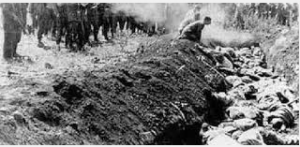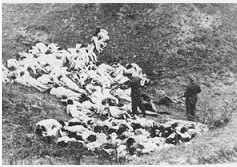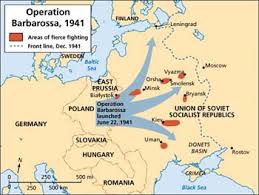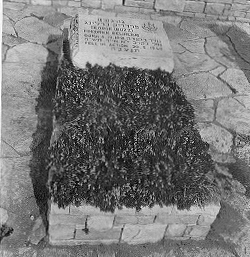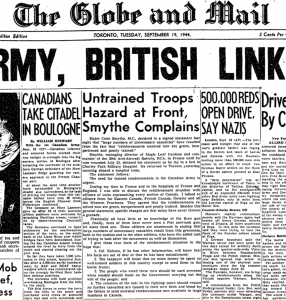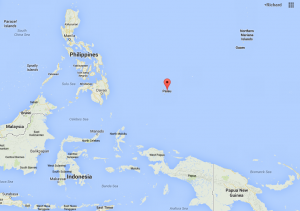Every year on Yom Kippur, Jews around the world say a special prayer for the Jews killed at Babi Yar. Babi Yar is the name of a ravine on the outskirts of Kiev and on the eve of Yom Kippur, on September 29 and 30, 1941, some 35,000 Jews were massacred by the Nazis and their local accomplices. In the months after this, as many as 100,00 more were murdered there as well.
The atrocities at Babi Yar did not happen in isolation. They were the direct result of Hitler’s massive invasion of Russia called Operation Barbarossa and the Soviet surrender of the City of Kiev just a few days before, on September 26, 1941
On June 22, 1941, some 3 million Germans attacked eastwards along what would become a 1000 mile front with more than 500,000 vehicles and more than 600,000 horses. They attacked with three different army groups each heading in a different direction.
Army Group North headed northeast through the Baltic States with the goal of taking Leningrad.
Army Group Center headed almost straight east with the goal of taking Moscow.
Army Group South headed southeast towards the Crimea and the oil fields of Lake Baikal.
To stop the Nazi invasion, Stalin had roughly 2 million men at his disposal, but little in the way of leadership. The Soviet General Staff was in a complete state of disrepair as Stalin had spent the 20’s and 30’s purging the army of anyone who might have been a political rival to him. A number of top Generals had been purged from the Army and either killed or imprisoned. The remaining Generals were mostly inexperienced and for the six months after Barbarossa began, the Soviet Union lost nearly every military engagement, only holding back the advancing Nazis with suicidal charges and mass casualties.
As the Nazi juggernaut pushed into Russia with little or no resistance, the Soviets were forced to flee from nearly every battle. The only effective resistance that the Soviet Army could muster was to take refuge in the cities and towns and force the Germans to either bypass the city or fight door to door. This left the Germans with the decision to either bypass the cities and starve out the Soviet troops or spend a lot of time and suffer a lot of casualties fighting door to door. Hitler was dead set against bypassing cities and wanted the Wehrmacht to capture and destroy each one leaving no Soviet resistance behind the advancing front line. But all the Wehrmacht commanders, von Leeb, von Bock and von Rundstedt, as well as their superiors on the General Staff (Fritz Halder and Walther von Brauchitsch) wanted to bypass the cities and reach their objectives before the Russian winter arrived. They had all learned the lessons of Napolean’s march on Moscow from the previous century and knew that having to spend the winter in the Russian countryside was a deadly mistake. The arguing reached new heights when von Rundstedt bypassed Kiev in August leaving more than 500,000 Russian troops trapped in and around the city. Hitler demanded that Kiev be taken, the result of which was that von Rundstedt, in charge of Army Group South, had to stop his advance and turn his armored divisions around. Hitler also demanded that a large Panzer Group under Heinz Guderian (part of Army Group Center) which was well on its way to Moscow, be turned around to support the attack on Kiev.
Thus the city of Kiev was encircled and attacked during a period from about August 15 through about September 26, after which organized Sovet resistance in and around the city ended and the surviving soldiers were told to try to break out on their own. In the end, more than 300,000 Russian soldiers were taken prisoner and sent back to Germany for slave labor. Only a few would survive the war.
After the fall of Kiev, the Wehrmacht units involved reoriented themselves back towards Moscow and towards the Crimea. But the mistake had been made. The Nazi’s would never get to Moscow. The Russian winter arrived with the Wehrmacht forward units within site of the city and perhaps within site of victory. But that was as far as they would go. Instead the Germans would spend the winter out in the countryside with no proper winter clothing and little to eat. By the spring of 1942, the Soviet Army had rebuilt itself and the Germans would never take Moscow. Thus Hitler’s decision to stop the advance towards Moscow and to take Kiev turned out to be one of his biggest and most costly blunders. But it spelled doom for the Jews of Kiev.
Shortly after Kiev fell, the Nazis who followed the Wehrmacht into Russia began arriving. Hitler appointed Kurt Eberhard as the Military Governor of the Kiev area. And it was Eberhard, along with head of Army Group South’s Military Police Freidrich Jeckeln and the Commander of the Einsatzgruppe that followed Army Group South, Otto Rasch and his deputy, Paul Blobel, who decided to quickly murder Kiev’s Jews with the help of local Ukrainian sympathizers including the Kiev Police Force.
To ease the effort to round up Kiev’s Jews, they posted notices around the city telling Jews to report with all their documents and valuables to a certain intersection for resettlement at a certain time. The ruse worked and over 2-3 days, some 30,000 Jews showed up thinking that they were going to be resettled. They were quickly stripped of their possessions and taken to the ravine at Babi Yar. Upon arrival, they were forced to march into deep pits and told to stand at attention whereupon they were immediately shot in the head. Another group was then marched into the pits to stand above those just previously shot and they too were murdered. This went on for two days straight during which time nearly 35,000 Jews were murdered. Ukrainian Police soon began bringing more Jews from Kiev and the surrounding towns to Babi Yar. Over the next six months, perhaps as many as 150,000 Jews in total would be murdered there.
Babi Yar occurred during the early period of the Holocaust when the Nazis were committing a “Holocaust by bullets”. As time went by Himmler began to notice that even the most murderous of the SS were growing weary of shooting so many people. Morale began to suffer. Alchoholism rates began to sour. At the same time, as the Nazis captured more and more Russian territory, more and more Jews fell under their control. It was against this backdrop that the top Nazi’s met at Wannsee outside Berlin in January of 1942. Their final solution was to industrialize the murder of Europe’s Jews by using poison gas in huge gas chambers, killing hundreds and thousands at a time. As they pointed out, this would spare their soldiers of having to shoot them one by one. This lead to the construction of the death camps at Treblinka, Sobibor, Belzec, Majdanek and finally Auschwitz and the greatest mass murder in history. By the time it was over, 6 million Jews and countless others would perish.
Perhaps its interesting to know what happened to the perpetrators of these crimes at Babi Yar.
Kurt Eberhard, the military governor of Kiev, was captured by the US Army at the end of the war and incarcerated in Stuttgart. He committed suicide on September 8, 1947.
Freidrich Jeckeln, the SS Commander who accompanied Army Group South and, among his other duties, was in charge of the Einsatzgruppen that followed along behind Army Group South. He was captured by the Soviets right before the end of the war on April 28, 1945. He was tried, convicted, and hanged in Riga in February 1946.
Otto Rasch, in command of the Einsatzgruppe that actually did the killing was discharged from the Waffen SS later that year. He was indicted in September of 1947 but his case was discontinued in February of 1948 due to his ill health. He would escape the hangman’s noose as he died later that year in November of 1948.
Rasch’s direct report, Col. Paul Blobel, became an alcoholic and was removed from his position in January of 1942. But apparently he had not satisfied his blood lust because by June of 1942 he was assigned to Aktion 1005, a group whose purpose was to go around and try to hide the evidence of Nazi atrocities in Easter Europe. To accomplish this, the Nazis began digging up all the bodies that they had shot or gassed and tried to burn them on huge funeral pyres. Blobel was tried in Nuremberg as part of the Einsatzgruppen Trial. He was convicted and eventually hanged in June of 1951. A Nazi to the end, his last words were some sort of pathetic justification for his actions, not worth repeating.
